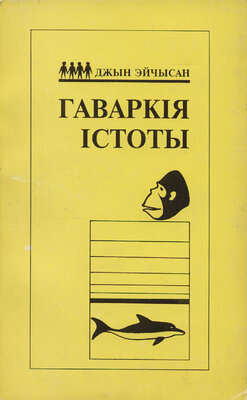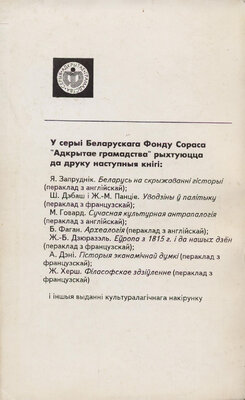Гаваркія істоты
Уводзіны ў псіхалінгвістыку
Джын Эйчысан
Выдавец: Беларускі Фонд Сораса
Памер: 220с.
Мінск 1995
Shattuck-Hufnagel, S. (1979), «Speech errors as evidence fora serialordering mechanism in sentence production», in Cooper and Walker (1979)
Shats, M. (1982), «On mechanisms of language acquisition: can features of the communicative environment account for development?», in Wanner and Gleitman (1982)
Sinclair-de-Zwart, H. (1969), «Developmental Psycholinguistics», in D.EIkind and J.Flavell (eds), Studies in Cognitive Development, Oxford: Oxford University Press
Skinner, B.F. (1957), Verbal ehavior, New York: Appleton-CenturyCrofts
Slobin, D.l. (1966), «The acquisition of Russian as a native language», in Smith and Miller (1966)
Slobin, D.l. (1966a), «Grammatical transformations and sentence comprehension in childhood and adulthood», Journal of Verbal Learning and Verbal Behavior, 5, pp. 219-27
Slobin, D.l. (1971), The Ontogenesis of rammar, New York: Academic Press
Slobin, D.l. (1971a), «On the lerning of morphological ruies», in Slobin (1971)
Slobin, D.l. (1971b), Psycholinguistics, lenview, Illinois: Scott Foresmann
Slobin, D.l. (1973), «Cognitive prerequisites for the development of grammar» in Ferguson and Slobin (1973)
Slobin, D.l. (1975), «On the nature of talk to chilren», in Lenneberg and Lnneberg (1975)
Slobin, D.l. (1977), «Language Change in childhood and in history», in Macnamara (1977)
Slobin, D.l. (1979), «The origins of grammatical encoding of events», in W.Deutsch (ed.), The Child's Construction of language, London: Academic Press
Slobin, D.l. (1982), «Universal and particular in the acquisition of language», in Wanner and Maratsos (1982)
Slobin, D.l. (1985), The Crosslinguistic Study of Language Acquisition, vols.1 and 2, Hillsdale, NJ: Lawrence Erlbaum
Slobin, D.l. (1985a), «Why study acquisition crosslinguistically?», in Slobin (1985)
Slobin, D.L, and Welsh, C.A. (1967), «Elicited imitation as a research tool in developmental psycholinguistics», in Ferguson and Slobin (1973)
Smith, F., and Miller, G.A. (1966), The Genesis of Language, ambridge, Mass: MIT Press
Smith, N.V. (1973), The Acquisition of Phonology-. A Case Study, Cambridge: Cambridge University Press
Snow, C.E., and Ferguson, C.A. (1977), Talking to Children: Language Input and Acquisition, Cambridge: Cambridge University Press
Springer, S.P., and Deutsch, G. (1985), Left Brain, Right Brain (rev. edn), New York: Freeman
Stahlke, .F.W. (1980), «On asking the question: can apes learn language?», in Nelson (1980)
Stoel-Gammon, C., and Cooper, A. (1984),»Patterns of early lexical and phonological development», Journal of Child Language, 11, pp. 247-71
Struhsaker, T.T. (1967), «Auditory communication among vervet monkeys (Cercopithecus aethiops)», in S.A.Altmann (ed), Social communication among Primates, Chicago: Chicago University Press
Stowe, L. (1988), Models of Gap-Location in the Language Processor, Bloomington, Ind: Indiana University Linguistics Club
Studdert-Kennedy, M. (1983), Psychobiology of Language, Cambridge, Mass: MIT Press
Swinney,D. (1979), «Lexical access during sentence comprehension: (Re)consideration of context effects», Journal of Verbal Learning and Verbal Behavior, 18, pp. 645-59
Sperber, D., and Wilson, D. (1986), Relevance: Communication and Cognition, Oxford: Basil Blackwell
Tanenhaus, M.K. (1988), «Psycholinguistics: an overview», in Newmeyer (1988), vol.3
Tanenhaus, M.K., Carlson, G.N., and Seidenberg, M.S. (1985), «Do listeners compute linguistic representations», in Dowty, Karttunen and Zwicky (1985)
Tanenhaus, M.K., Leiman, K.H., and Seidenberg, M.S. (1979), «Evidence for multiple stages in the processing of ambiguous words in syntactic contexts», Journal of Verbal Learning and Verbal Behavior, 18, pp. 427-41
Tavakolian, S.L. (1981), Language Acquisition and Linguistic Theory, Cambridge, Mass: MIT Press
Terrace, H.S. (1979), Nim, New York: Knopf
Terrace, H.S. (1979a), «How Nim Chimpsky changed my mind», Psychology Today (November 1979), pp. 65-76
Terrace, H.S. (1983), «Apes who «talk»: language or projection of
language by their teachers?», in de Luce and Wilder (1983)
Terrace, H.S., Peitto, L.A., Sanders, R.J., and Bever, T.G. (1980), «On the grammatical capacity of apes», in Nelson (1980)
Thorpe, W.H. (1961), Bird Song: The io/ogy of Vocal Communication and Expression in Birds, Cambridge: Cambridge University Press
Thorpe, W.H. (1963), Learning and Instinct in Animals (2nd edn), London: Methuen
Thorpe, W.H. (1972), «Vocal communication in birds», in R.A.Hinde (ed.), Non-Verbal Communication, Cambridge: Cambridge University Press.
Van Riemsdijk, H., and Williams, E. (1986), Introduction to the Theory of Grammar, Cambridge, Mass: T Press
Vargha-Khadem, F., O’Gorman, A.M., atters, .V. (1985), «Aphasia and handedness in relation to hemisphere side, age at injury and severity of cerebrall lesion during childhood», Brain, 8, pp. 677-96
Vihman, M.M., Macken, M.A., Miller, R., Simmons, H., and Miller, J. (1985), «From babbling to speech: a re-assessment of the continuity issue», Language, 61, pp. 397-445
von Frisch, K. (1950), Bees: Their ision, Chemical Sense and Language, Ithaca, NY: Cornell University Press
von Frisch, K. (1954), The Dancing Bees, London: Methuen
von Frisch, K. (1967), The Dance andrientation of ees, translated by L.E.Chadwick, Cambridge, Mass Harvard University Press
Vygotsky, L.S. (1962), Thought and Language, (Cambridge, Mass: MIT Press
Wales, R.., and Walker, E. (1976), New Approaches to Language Mechanisms, Amsterdam: North Holland
Walker, E. (1978), Explorations in the Biology of Language, ussex: The Harvester Press
Wanner, E. (1974), On Remembering, Forgetting and Understanding Sentences: A Study of the Deep Structure Hypothesis, The Hague: Mouton
Wanner, E., and Gleitman, L.R. (1982), Language Acquisition: The State of the Art, Cambridge: Cambridge University Press
Wanner, E., and Maratsos, M. (1978), «An ATN approach to comprehension», in Halle, resnan and Miller (1978)
Wason, P.C. (1965), «The contexts of plausible denial», Journal of
Verbal Learning and Verbal ehavior, 4, pp. 7-11. Also Oldfield and Marshall (1968)
Waterson, N., and Snow, C. (1978), The Development of Communication, Chichester: John Wiley and Sons
Watt, W.C. (1970), «On two hypotheses concerning psycholinguistics», in Hayes (1970)
Weir, R.H. (1962), Language in the Crib, The ague: Mouton
Weir, .H. (1966), «Some questiins on the child’s learning of phonology», in Smith and Miller (1966)
Wells, G. (1974), «Learning to code experience through language», Journal of Child Language, 1, pp. 243-69
Wells, G. (1979), «Learning and using the auxiliary verb in English», in Lee (1979)
Wells, G. (1980), «Apprenticeship in meaning», in Nelson (1980)
Wells, G. (1982), Interactive Encounters with Language, Cambridge: Cambridge University Press
Wells, G. (1986), The Mearning Makers: Children Learnin Language and Using Language to Learn, London: Hodder and Stoughton
Wells, G., and Robinson, W.P. (1982), «The role of adultspeech in language development», in C.Fraser and K.R.Schere (eds), Advances in the Social Psychology of Language, Cambridge: Cambridge University Press
Wexler, K., and Culicover, P.W. (1980), Formal Principles of Language Acquisition, Cambridge, Mass: MIT Press
Wilbur, R.B. (1987), American Sign Language: Linguistics and Applied Dimensions, Boston: Little Brown
Wilson, B., and Peters, A.M. (1988), What are yoe cookin», on a hot?», Language, 64, pp. 249-73
Yamada, J. (1988), «The independence of language: edidence from a retarded hyperlinguistic individual», in Hyman and Li (1988)
Yule,G. (1985), The Study of Language, Cambridge: Cambridge University Press
Yngve, V. (1961), «The depth hypothesis», reprinted in F.W.Householder (ed.), Syntactic Theory I: Structuralist, Harmondsworth: Penguin (1972)
Zangwill, O.L. (1964), «Intelligence in aphasia», in De Reuck and O’Connor
Zangwill, O.L. (1973), «The neurolofy of language», in N.Minnis (ed.), Linguistics at Large, St Albans: Paladin
A
Абрамс, К. 238 агаворкі
агульная тэорыя 252-260 Адам ("Гарвардскае дзіця") 8488,129-133,164,282 антыцыпацыі (агаворкі) 259 адзольнасць (фармальная рыса мовы) 32-33 Ашэр, Дж. 92 аддаленасць 32,35-36 адмоўі 80,129-136 аднаслоўныя выказванні 113-117 Акеакамаі (дэльфін ) 51-52 Акмаджан, А. 280 Альтман, С. 32 аперантнае абумоўліванне 16 апрацоўка мовы (асэнсаванне), гл. разуменне;спараджэнне афазія, гл. дысфазія ацзначная методыка 106
S
Баарс, Б. 262
Баз (дэльфін) 38-39
Балард, Д.Х. 285
Бар-Адан, А. 81-82
Барэт, М. 282
Басціян, Дж. 38-39
Батэрворт, Б. 251
Бауэрман, М. 121,167,169,283
Бафэры, Т. 62
Белуджы, У. 17,75,128-131
Бенет-Кастар, Г. 84-282
Берка, Дж. 127
Бернстайн, Б. 93
Бівер.Г.Г. 21,22,30,92,151,196,
199,201,204,213,216,221,235236,238,
242,249,283-284
біялагічна абумоўленыя паводзі-
ны 71-79
Бланк, М. 151
Блох, Б. 32
Блум, У. 115-116,120-121,166,283
Блументаль, А.Л. 196,216
Блумстайн, С. 284
Бранч, К. 61-62
Браун,Р.17,40,75,84,86,119,122,131, 155,249,262,280,282-283
Брунэр, Дж. 281
Брэйн, М.Д.С. 125-126,283
Брэснан, Дж. 237,277
Бумер Д.С. 251,267
Бэйтс, I. 84,276,281,283
в
Варга-Кадэм, Ф. 91
Векслер, К. 22 выказванні з адзінага слова, гл. аднаслоўныя выказванні
Выгоцкі. Л.С. 114-115
Віман, М.М. 82
г
Г — структура, гл. глыбінная структура
Газаніга, М.А. 62
Газдан, Г. 17,75 галафраза 115 Гарднер, Б.Г. 40-43,51,281 Гарднер, Р.А. 40-43,51,281,285
Гарман, М. 283 гарызантальная (злева направа) мадэль 246
Гарэт, М. 21,30,150,193-196,213, 216,235-236,238,242,249,282-283 глыбінная структура 24,102-108, 142-145,179,190-191,196-202
Гляйтман, Л.Р. 91,121,155-156 205-206,283
Голдман-Айслер, Ф. 251
Голдман-Рэйсік, П.С. 91
Гоулд, Дж. Л. 275
граматыка 112
Гросу, А. 241
Грубер, Дж. 120,221
Грымшоу, Дж. 237
Грыфін, Д. 281
Грыфіц, П. 116-117
Гуа (шымпанзэ) 40 Гудглас, X. 283 Гудлак, X. Г. 145 гука-слыхавы канал, яго выкарыстоўванне 32-33 гуканне 80-81
д
Д.Т.К., гл. Дэрывацыйная тэорыя комплекснасці 190-195
Дакс, Ф. 58-60
 КНІГІ ОНЛАЙН
КНІГІ ОНЛАЙН


